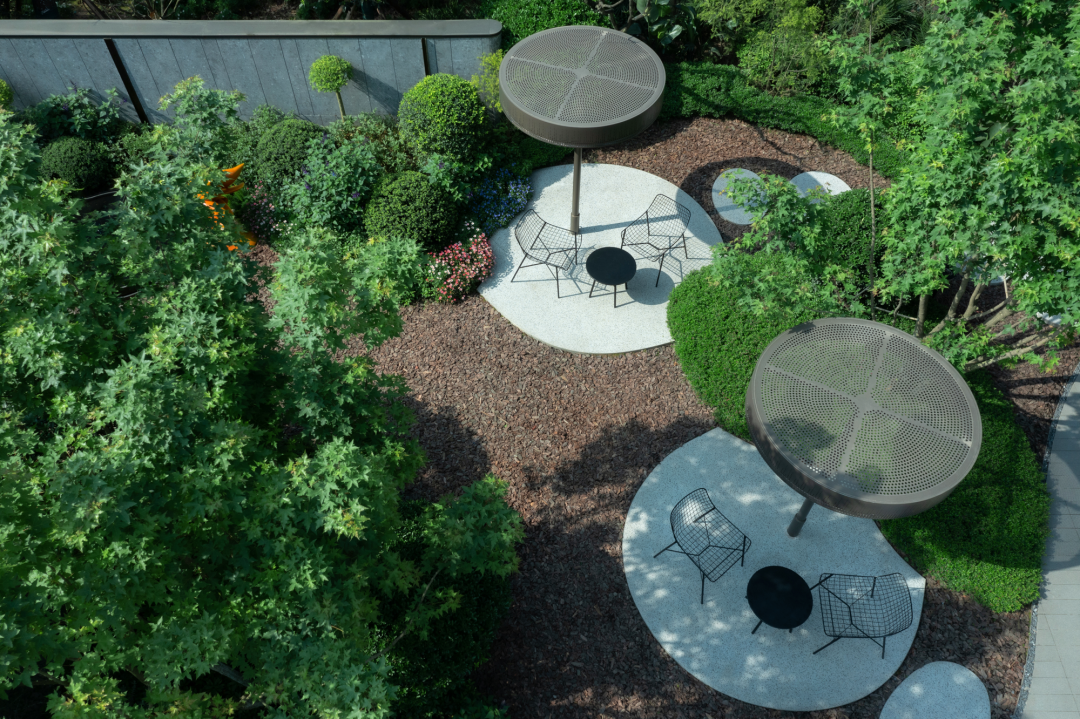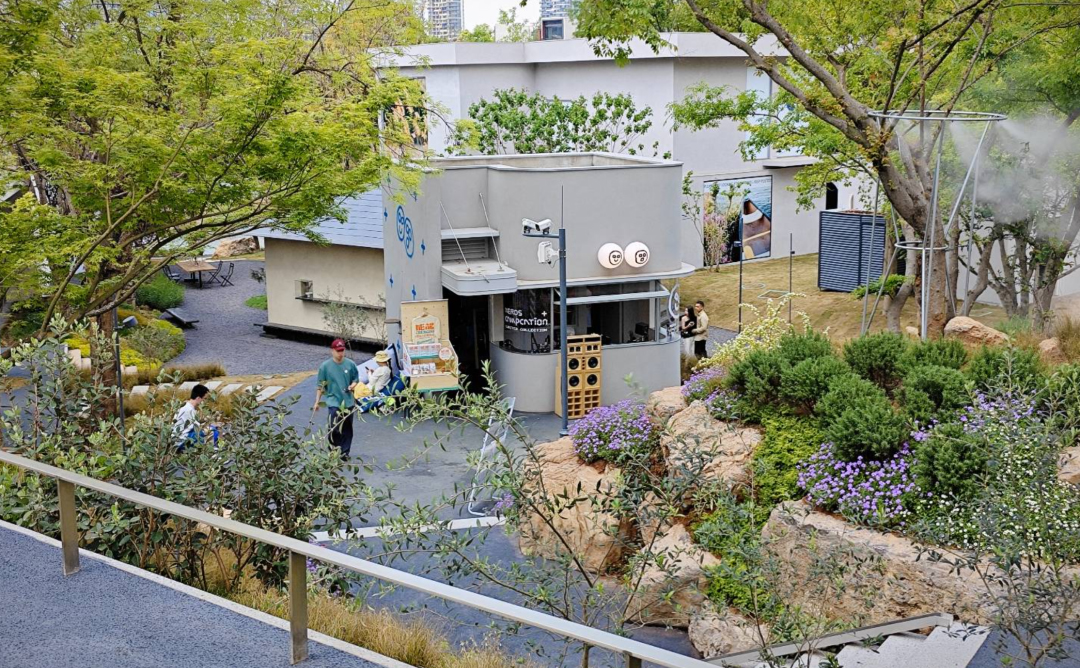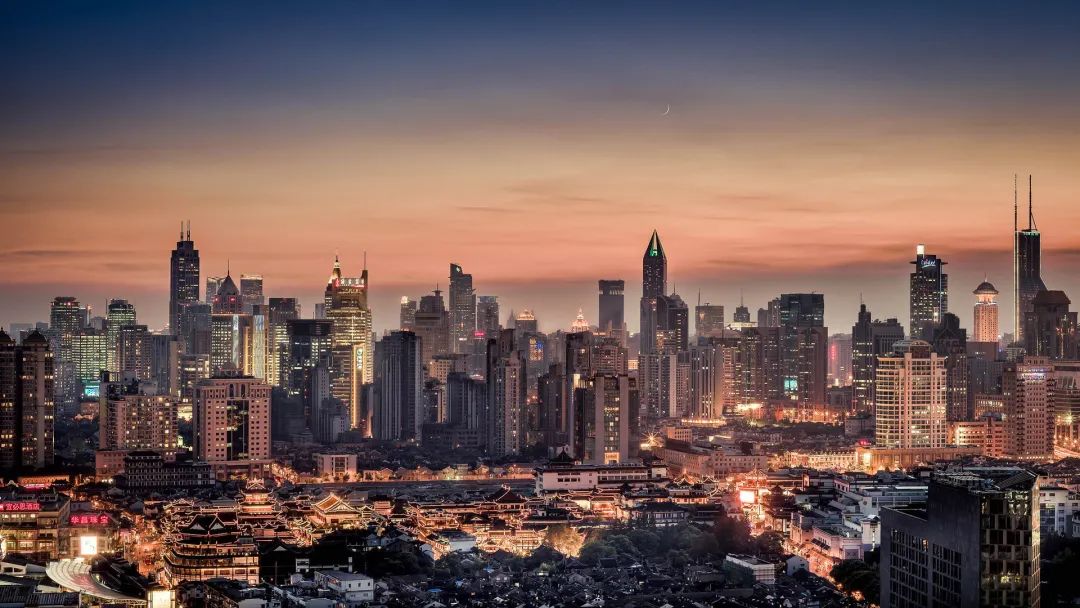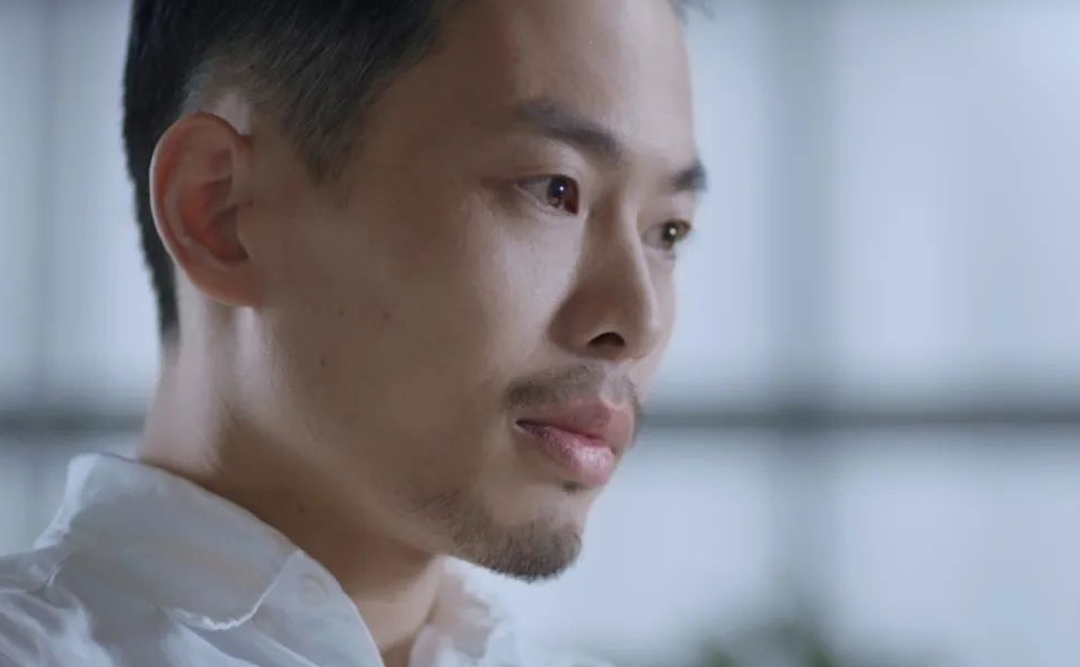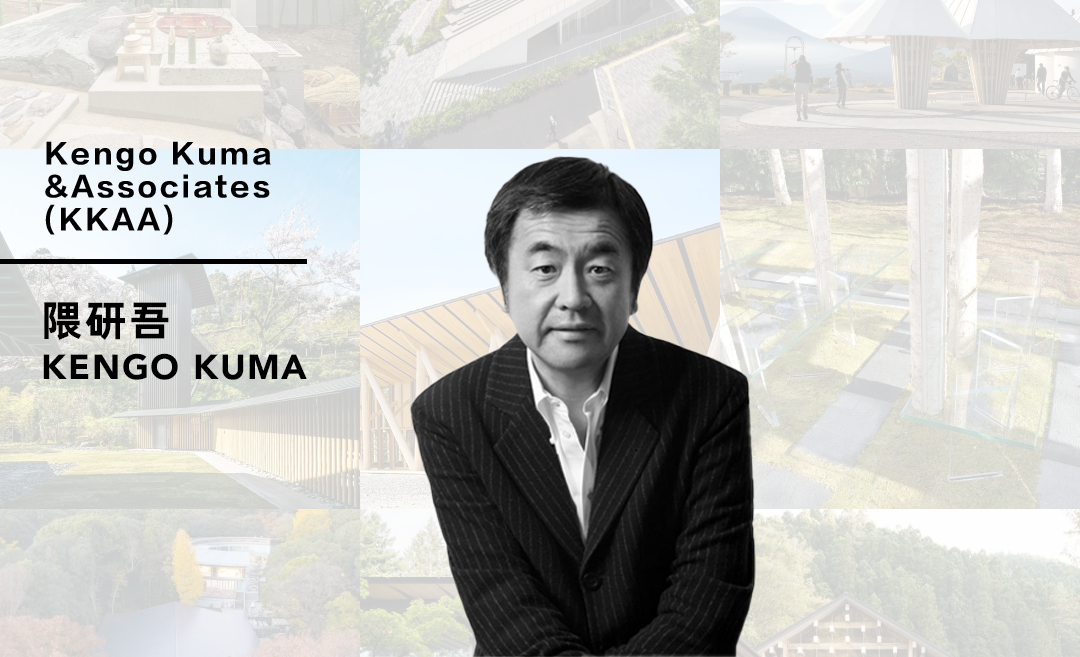
建筑自身存在的形体是可耻的。我想让建筑的轮廓暧昧化,也就是说,让建筑物消失。
--隈研吾
用融于环境的理念做建筑,用自然元素重构空间形体。本期「神奇事务所在哪里」要介绍的事务所是隈研吾建筑都市设计事务所Kengo KumaAssociates(KKAA)。
Building with the concept of integration into the environment, reconstructing the space with natural elements. Kengo KumaAssociates (KKAA) is the architect of Kengo kumas urban design practice.
事务所概况
Office Profile
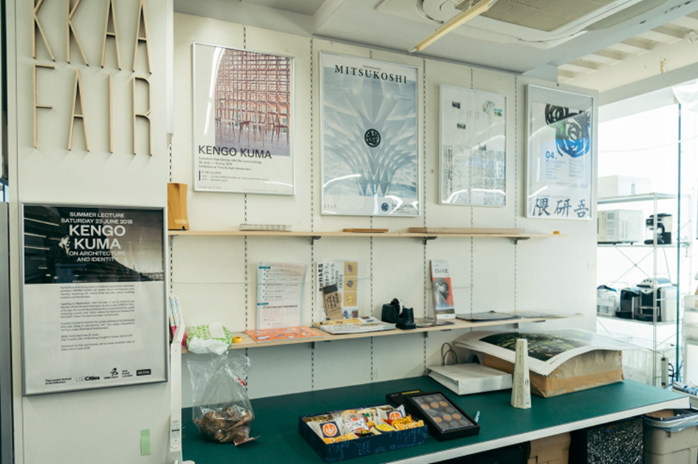
▲KKAA日本办公室
图片来源于网络
隈研吾建筑都市设计事务所(Kengo KumaAssociates)由日本当代著名建筑师隈研吾(Kengo Kuma)于1990年建立。目前KKAA在东京、北京、上海和巴黎均设有分所,员工现有300余人。
Kengo KumaAssociates was founded in 1990 by contemporary Japanese architect Kengo Kuma. Currently, KKAA has offices in Tokyo, Beijing, Shanghai and Paris with more than 300 employees.
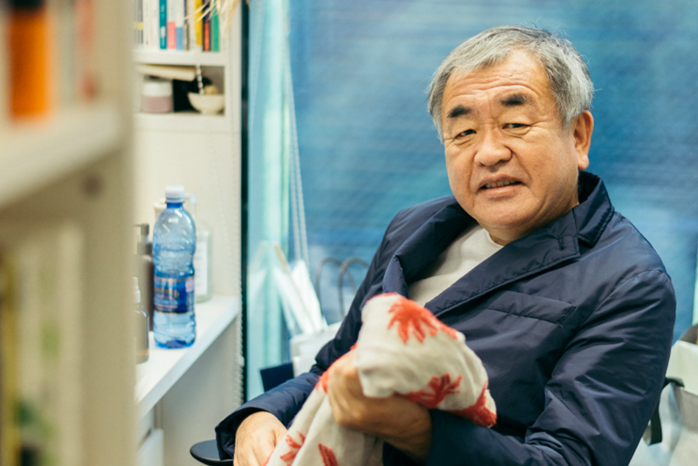
▲ 隈研吾 Kengo Kuma
图片来源于网络
隈研吾(Kengo Kuma)于1954年出生于日本横滨;1979年获东京大学建筑学硕士学位;1985-86年任美国哥伦比亚大学客座研究员;1990年成立隈研吾建筑都市设计事务所;2001-08年任庆应义塾大学教授;2009年起至今任东京大学教授,并兼任RIBA国际会员,AIA(美国建筑家协会)名誉会员的职务,享有极高的国际声誉。
Kengo Kuma was born in 1954 in Yokohama, Japan; He received his Masters degree in architecture from The University of Tokyo in 1979. From 1985 to 86, he was a visiting research fellow at Columbia University. In 1990, he founded Kengo Kuma Architectural And Urban Design Firm. 2001-08 Professor at Keio University; Since 2009, he has been a professor at The University of Tokyo. He is also a member of RIBA International and an honorary member of AIA (American Association of Architects).
设计哲学
Design Philosophy
隈研吾主张设计融合自然和文化,提出温和、人性化的建筑观念,擅于使用木材、泥砖、竹子、石板、纸或玻璃等天然建材,结合水、光线与空气,创造外表看似柔弱,却更耐震、且让人感觉到传统建筑的温馨与美的负建筑。隈研吾还经常把日本禅意美学的侘寂融入现代主义建筑体当中。他采用一种与20世纪当代主义截然相反的方式,摈弃工业化的材质,从抽象、极简里脱身,让空间蕴含着过去又定义着未来。
Kengo Kuma research we design the fusion of nature and culture, mild and humanized architectural concept is put forward, good at using timber, mud brick, the natural materials such as bamboo, stone, paper, or glass, water, light and air, create the appearance seems weak, but more seismic, and let a person feel the warmth of traditional buildings and the beautiful negative building. Kengo Kuma often incorporated wabi-sabi, a Japanese Zen aesthetic, into modernist architecture. In a completely opposite way to 20th century modernism, he abandoned industrial materials, got away from abstraction and minimalism, and let space contain the past and define the future.
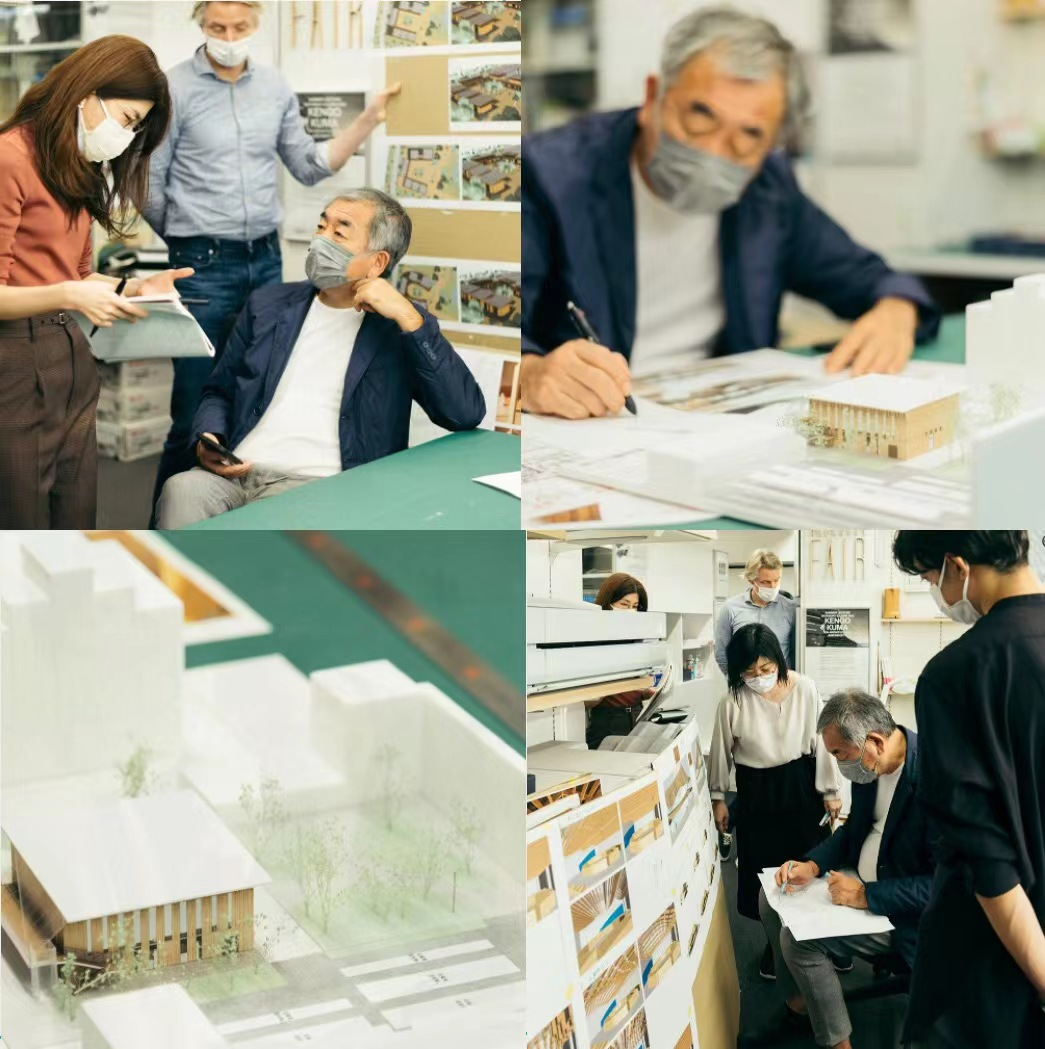
▲ 图片来源于网络
隈研吾并不认同以工整为美的建筑理念,而是开创了自己的放弃美学风格。他的建筑贴近自然,作为日本第四代建筑师的领军人物,他更强调木与绿的理念,他曾说过建筑物最终的归宿必定是大地,这种放弃美学的概念,让他的建筑作品始终散发着隈研吾式的光芒。
Kengo Kuma did not subscribe to the idea of beauty is neat, but created his own school of renunciation aesthetics. His architecture is close to nature. As the leading figure of the fourth generation of Japanese architects, he emphasizes the concept of wood and green. He once said that the ultimate home of buildings must be the earth.

▲ 图片来源于网络
隈研吾认为,强建筑之脆弱与它的恶紧密相连:其一是体量庞大,越大越招摇,越大越碍眼;其次是物质的消耗,体积越大,消耗物质越多,而地球资源却日渐枯竭;再有就是建筑物的不可逆改性,一旦完成,寿命比人长得多,它坚固的外表仿佛在嘲笑人类短暂而脆弱的生命。隈研吾决心摒弃强建筑的理念,提出了他的 负建筑、弱建筑的理念,那就是要把建筑作为配角、而要把环境放在主要位置。他认为,与强建筑相比,弱建筑或许更经得起冲击,而更为重要的是,它还能让失去安全感的现代人感受到传统建筑的温情和柔性之美。
According to Kengo Kuma, the fragility of a strong building is closely related to its evil : First, it is huge, and the bigger it is, the more ostentatious it is. Second is the consumption of material, the larger the volume, the more material consumption, and the earths resources are increasingly exhausted; Then there is the irreversible modification of the building, once completed, the life is much longer than people, its sturdy appearance seems to mock the short and fragile life of human beings. Kengo Kuma decided to abandon the idea of strong architecture and put forward his concept of negative architecture and weak architecture, which is to take architecture as a supporting role and put the environment in the main position. In his opinion, weak buildings may be better able to withstand impact than strong buildings, but more importantly, they can let insecure modern people feel the warmth and flexibility of traditional buildings.
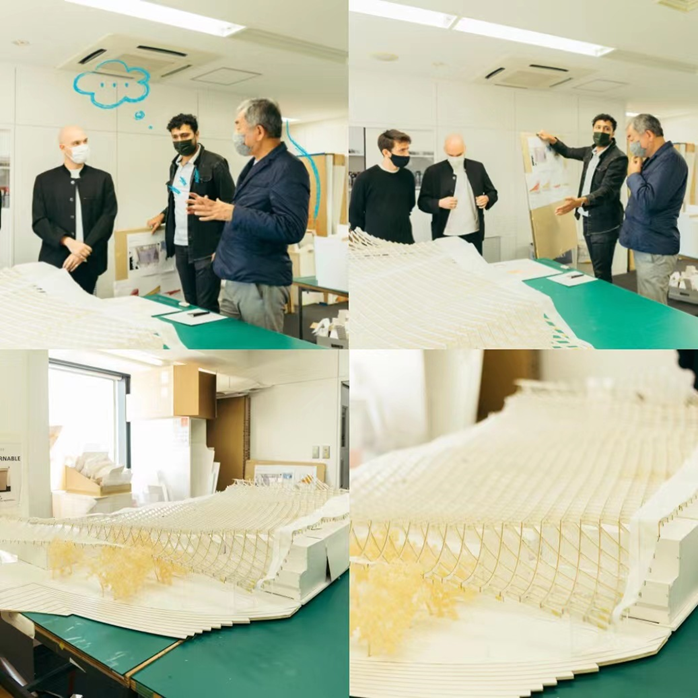
▲ 图片来源于网络
因此,隈研吾的设计哲学,是消弭了建筑和环境割裂对人类释发善意的建筑,是不张扬,不卑不亢,关照生活的初衷,诚实,坚持空间与时间的对话,温暖而朴实的建筑,是从建筑本位和单体层面都回归生活,造就以人以生活而不是以建筑为中心的场景。
Kengo Kuma research of our design philosophy is, therefore, removed the split between buildings and environment for human interpretation of the white building, is not make public, supercilious, care for the purpose of life, honesty, insist on space and time dialogue, warm and simple construction, from the construction standard and monomer level back to life, made by a person with life rather than construction as the center of the scene.
作品展示
Design Portfolio
01.2021
日本京都湯道亭
Kyoto Yudo Pavilion

Kei Sugimoto
隈研吾团队在京都一座寺庙的竹林中打造了一个漂浮的临时织物亭。通过将白色特卫强纸编织成三维结构,建筑师在浴池上方搭建起一座织物建筑。在这个半露天浴池中,游客可以在织物投下的光影中尽享热汤。简单的平面被转变为一处三维构造。以周围竹子支撑织物的方法正契合了负建筑的理念,白色布料将回应自然,随风摆动。
A temporary fabric pavilion was floated in the bamboo grove of a temple in Kyoto.A flat Tyvek was woven into a three-dimensional structure, and a bathtub was placed underneath this fabric architecture to create a semi-outdoor bath where visitors could play with the hot water in the filtered light. A simple flat surface was transformed into a three-dimensional architecture.The method of using the surrounding live bamboo as a support for the cloth is defeated architecture itself, and the white cloth sways as the wind blows.

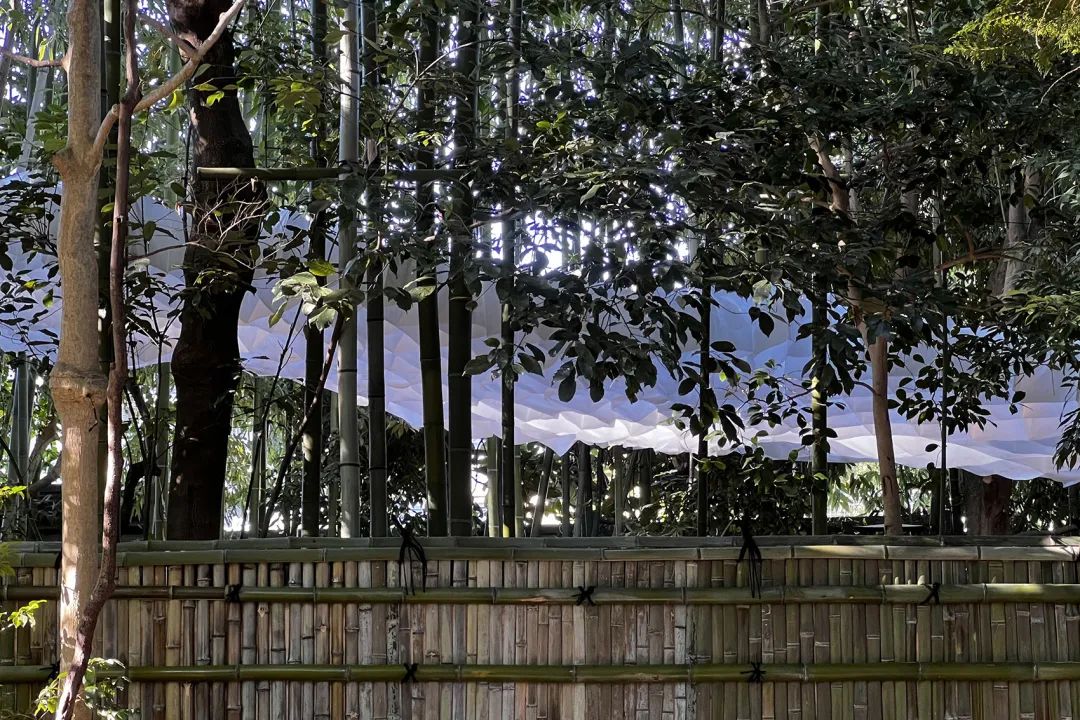
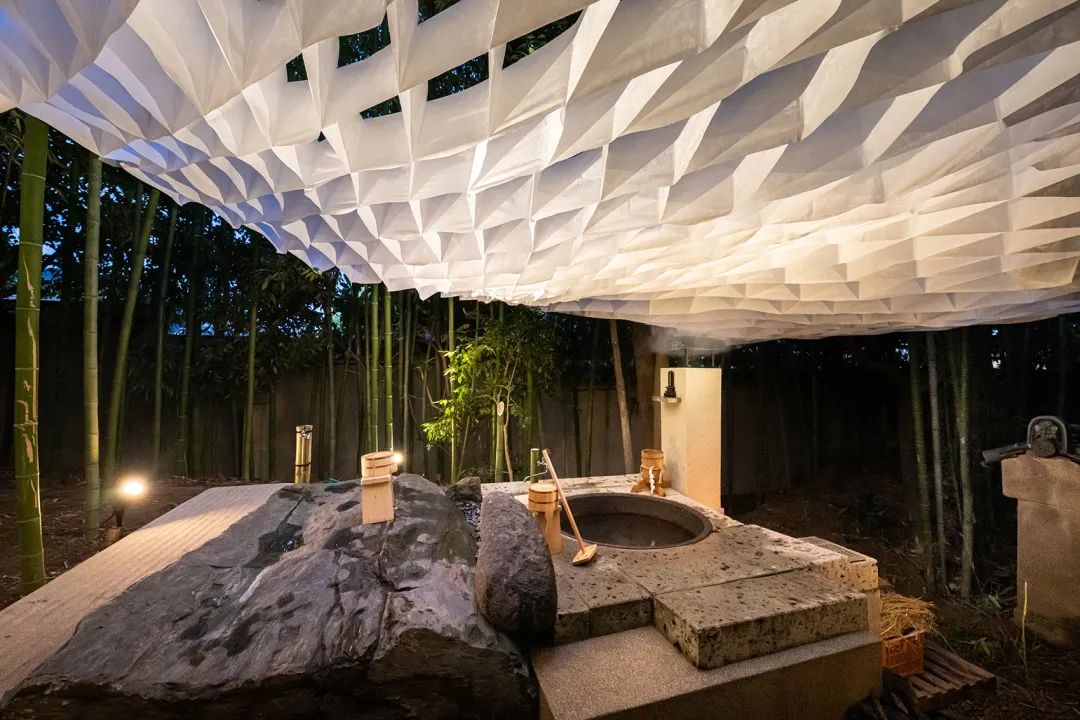
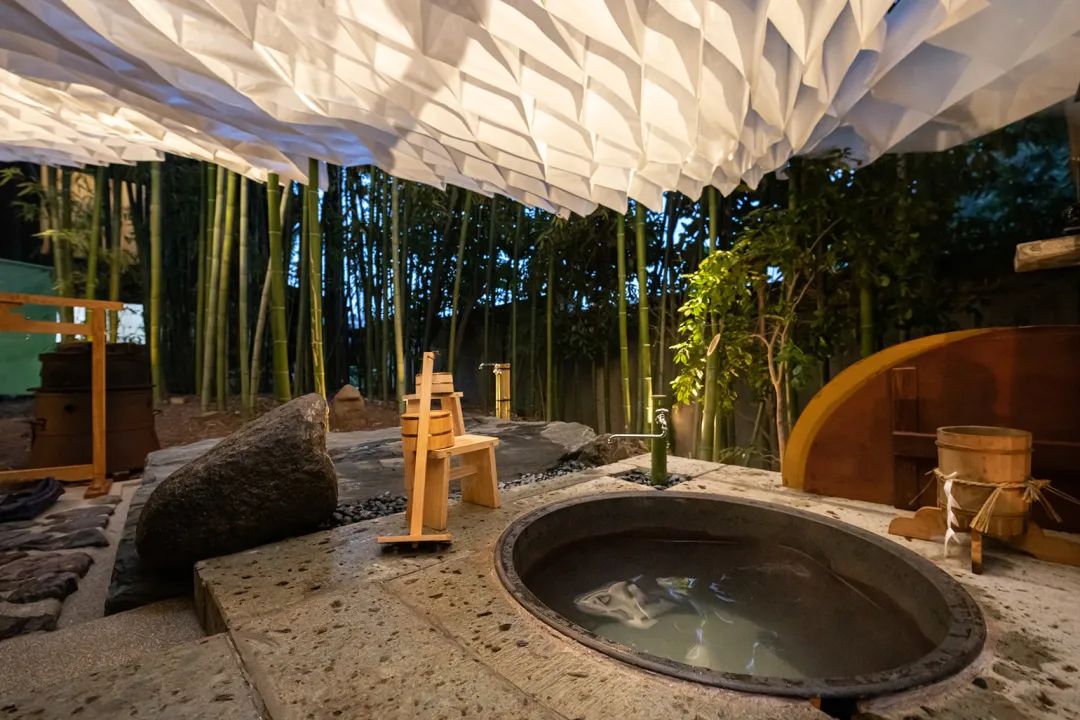
Kei Sugimoto
02.2021
东京工业大学Hisao Hiroko Taki广场
Tokyo Institute of Technology Hisao Hiroko Taki Plaza

Kawasumi・Kobayashi Kenji Photograph Office
项目位于东京工业大学校园的入口处,是隈研吾事务所为该校设计建造的全新广场,作为校园内全新的绿色公共空间,为学生们提供了舒适宜人的社交与休闲场所。东京工业大学的钟楼是学校里最为显著的地标建筑,为了确保人们能从学校正门清晰地看到钟楼,设计师将大部分建筑隐藏于地下,而地面上的部分则形成一座绿色的山丘,与周围的校园景观融为一体。
Located at the entrance of the Tokyo Institute of Technology, we designed a platform to house student activity. To maintain a clear vista of the clocktower, a prominent landmark for the campus, most of the building sits underground. Above ground, the building takes on a lush mound-like form, seamlessly integrating with the surrounding landscape. The roof which is composed of stepped greenery and bleachers, resonates with the green slanted wall of the adjacent library, collectively creating a green valley.
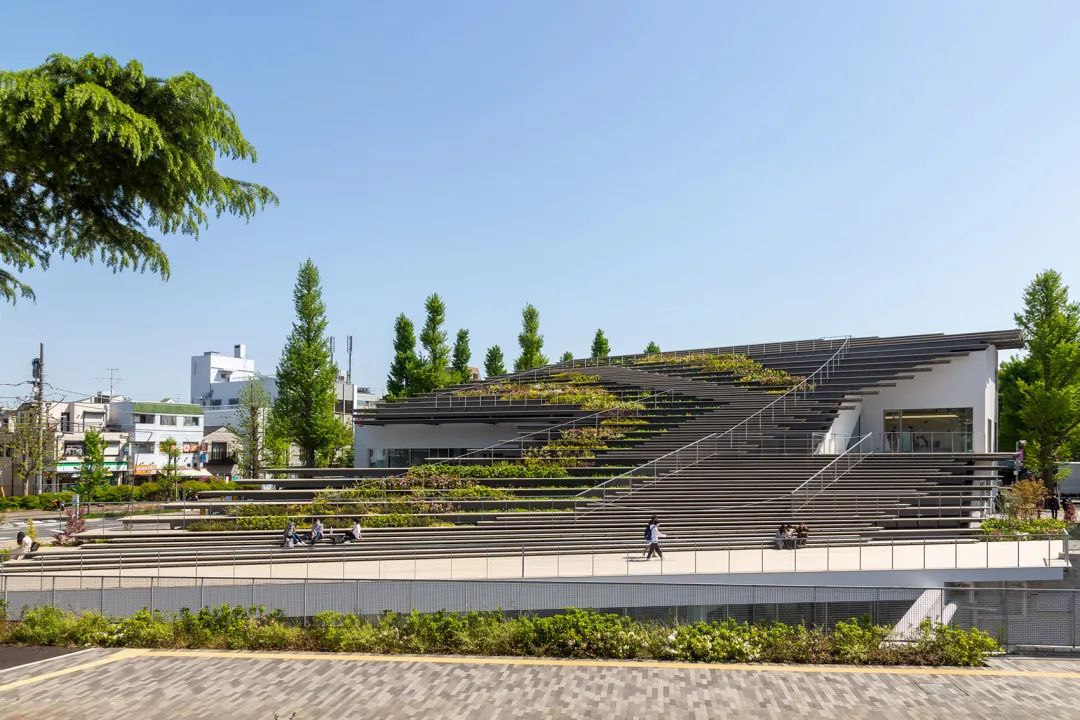
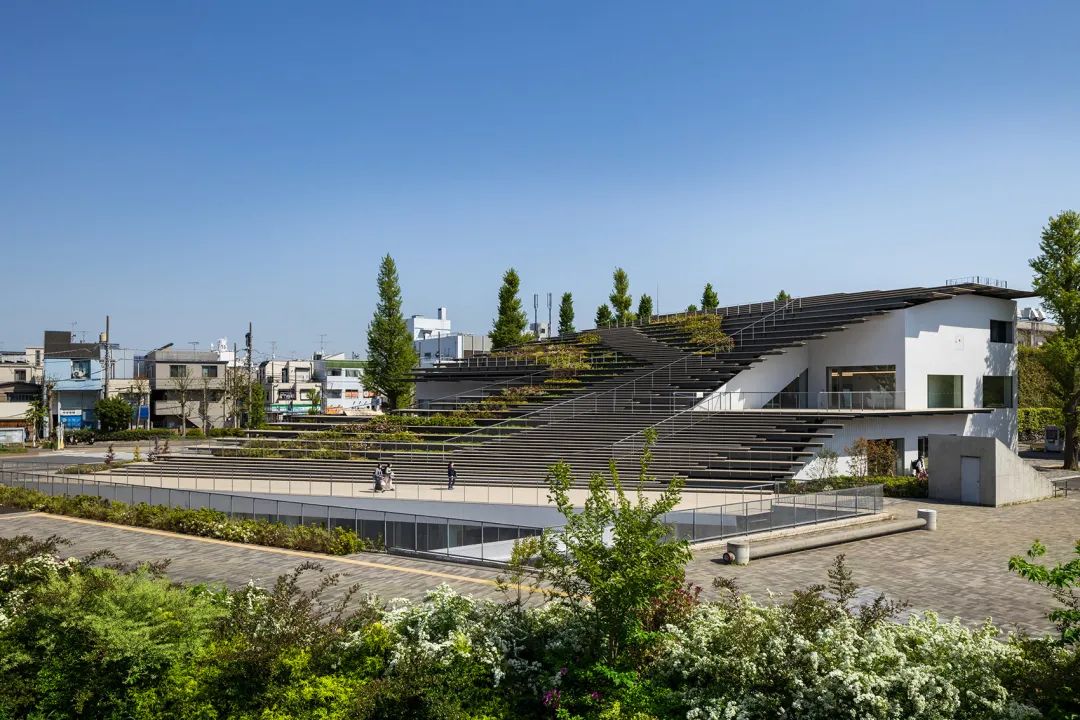

Kawasumi・Kobayashi Kenji Photograph Office
建筑的设计是从屋顶的整体剖面开始的,然后是扇形的露天平台与带形阶梯,最终形成了宛如河滩三角洲一般的建筑形式与屋顶轮廓,实现了建筑与校园景观之间的相互渗透。阶梯式的绿色屋顶将自然景观引入建筑,模糊了室内空间与外部景观之间的界限。这种屋顶形式创造出不同层次的活动空间,为学生们提供了丰富且有趣的共同学习场所与演讲交流的平台。
In order to consider many complex site conditions, we first determined the overall sectional profile of the roof, followed by the strip-like steps of the bleachers fanning out. This resulted in a roof silhouette that resembles the landscape of a river delta that spills into the campus. The line between the interior space and exterior landscape is blurred by continuing the stepped landscape into the building. This allows activities such as co-learning and joint workshops to be held simultaneously on different levels.

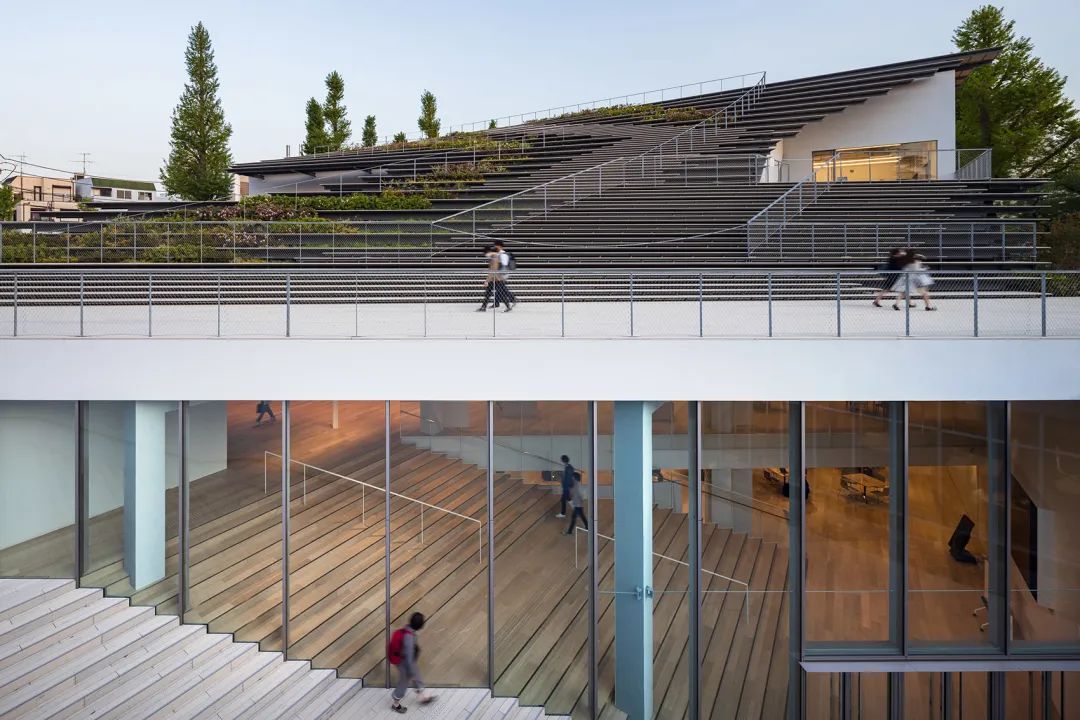
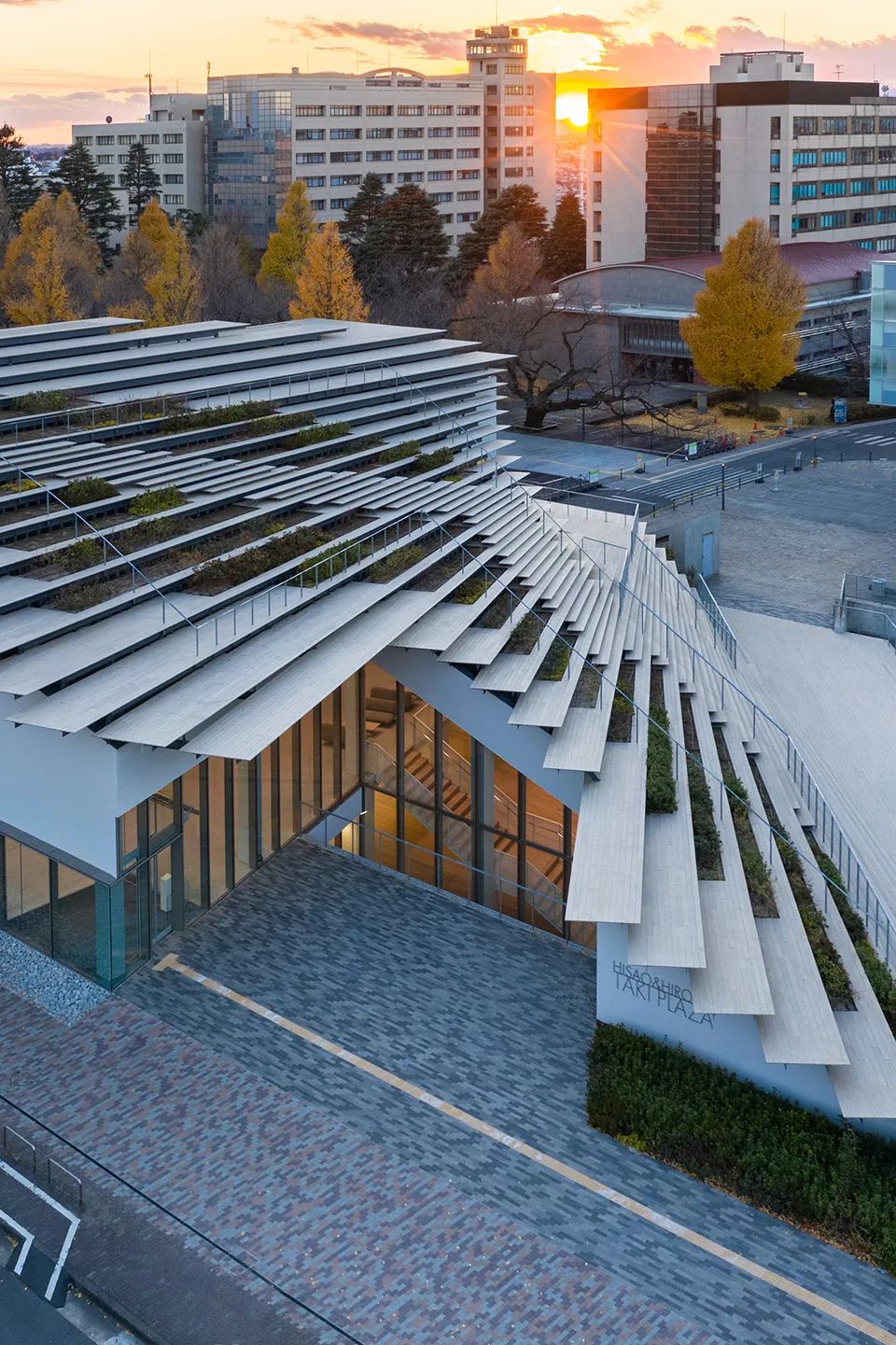
Kawasumi・Kobayashi Kenji Photograph Office
03.2021
日本誓言之丘公园展望台
Oath Hill Park

Kawasumi・Kobayashi Kenji Photograph Office
在Tenbou公园深处,知名的金太郎富士见徒步线路中段,隈研吾事务所设计了一座凉亭和卫生间,与富士山高耸的美丽外观交相辉映。建筑采用木梁和木柱,如同一把雨伞。设计灵感来自富士山抛物线状的山脊。梁和柱由中央的钢环固定在一起,两把雨伞连接,形成了坚固的框架结构。每种结构元素都由各自不同的作用。木材提供灵活性,钢材则坚硬牢固,阳光穿过膜制的屋顶,为凉亭带来温暖。木结构外侧覆盖了一层涂氟的膜材料,以抵御天气的影响。夜晚,木结构的剪影突显在月光照射下的森林之中。
Deep in the heart of Tenbou Park, halfway up the well renowned Kintaro Fujimi Hiking trail, we designed an arbor and restroom that resonates with the beautiful soaring form of Mount Fuji.Wooden beam and columns fan out in an umbrella form that draws inspiration from the parabolic ridgeline of Mount Fuji. The beam and columns are held together by steel rings in the center, and by connecting the two umbrellas, we achieved a rigid frame structure (Rahmen structure). Each structural material contributes in a different manner; The wood gives flexibility, the steel rigidity, and the roof membrane permeates light giving the arbor a welcoming warmth. The wooden structure is covered with a membrane finished with a fluorinated coating for weather proofing. At night, the wooden structure is silhouetted against a moonlit forest.
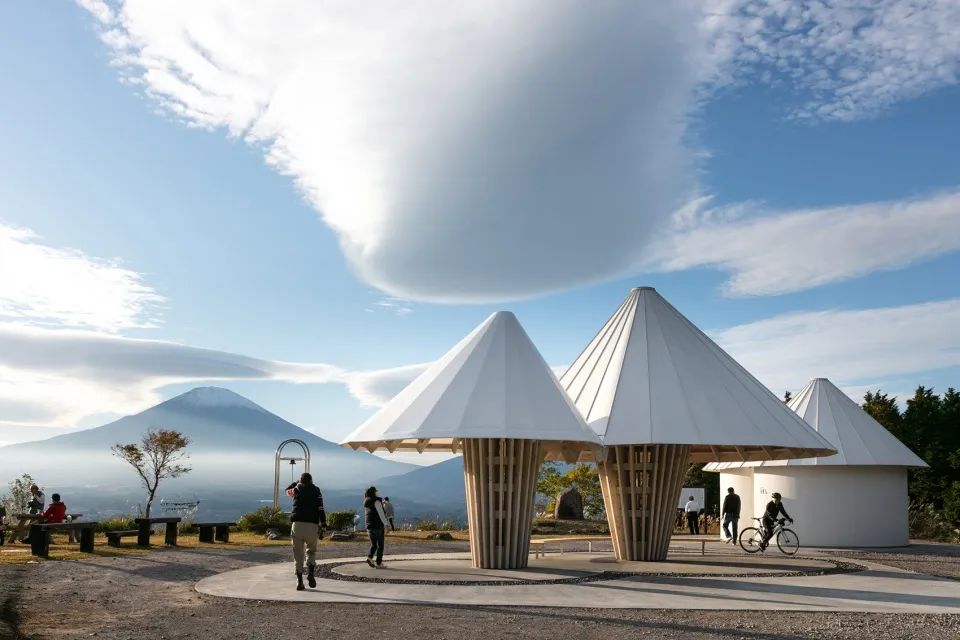

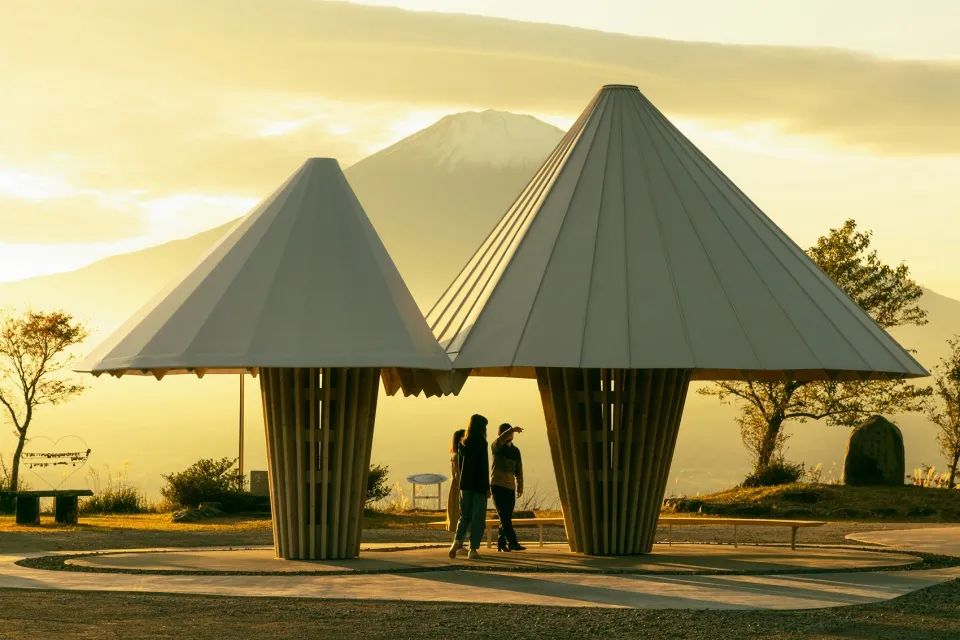
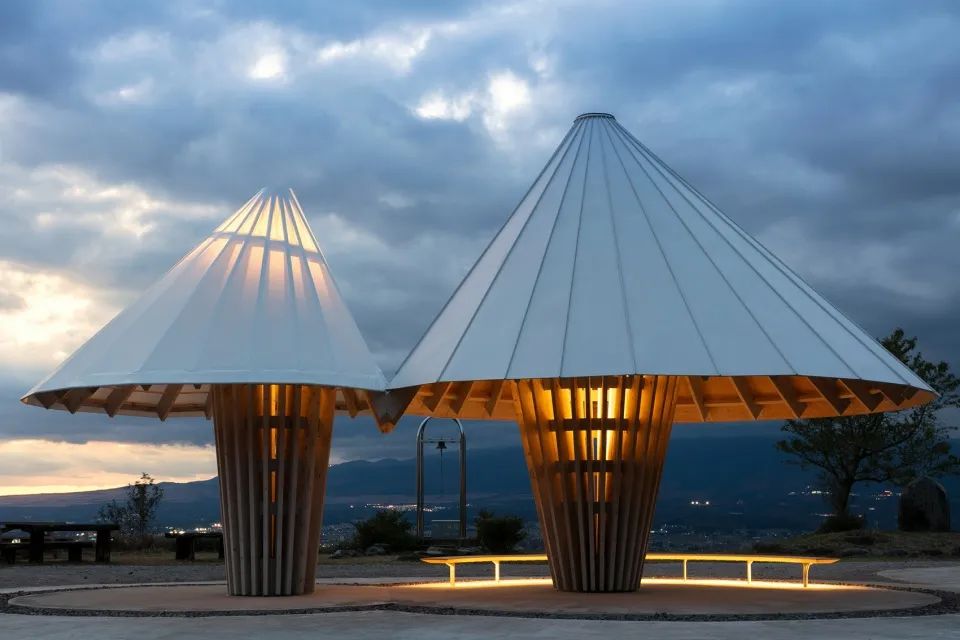

Kawasumi・Kobayashi Kenji Photograph Office
04.2020
日本竹田市历史文化博物馆
Taketa History and Culture Museum

Kawasumi・Kobayashi Kenji Photograph Office
博物馆位于竹田市的城堡小镇,这里以坚不可摧的丰后国冈城城堡闻名。这座博物馆沿着水道而建,融合了白色墙体与竹栅,看似一条长长的篱笆。烟熏竹栅延伸至博物馆内部,这里展示了城堡小镇的历史和当地文人画家田能村竹田的作品。博物馆后方的斜坡上是田能村竹田的故居,与博物馆通过覆盖格栅的电梯相连,创造出将历史渗透到整个城镇的设计。
This museum is located in the castletown of Taketa which is famous for its impregnable Bungo Okajo Castle.Situated along a water channel, this museum is designed to look like a long fence by combining the elements of a white building wall and bamboo lattice. The smoked bamboo lattice is extended inside the museum, where the history of this castletown and works of art by the literarti painter Chikuden Tanomura who is from the Oka Domain (clan) are on display. The historical Chikuden-sou (former residence of Chikuden Tanomura) situated on a slope behind the museum is connected by an elevator which is covered by a lattice, creating a design that exudes history into the entire town.


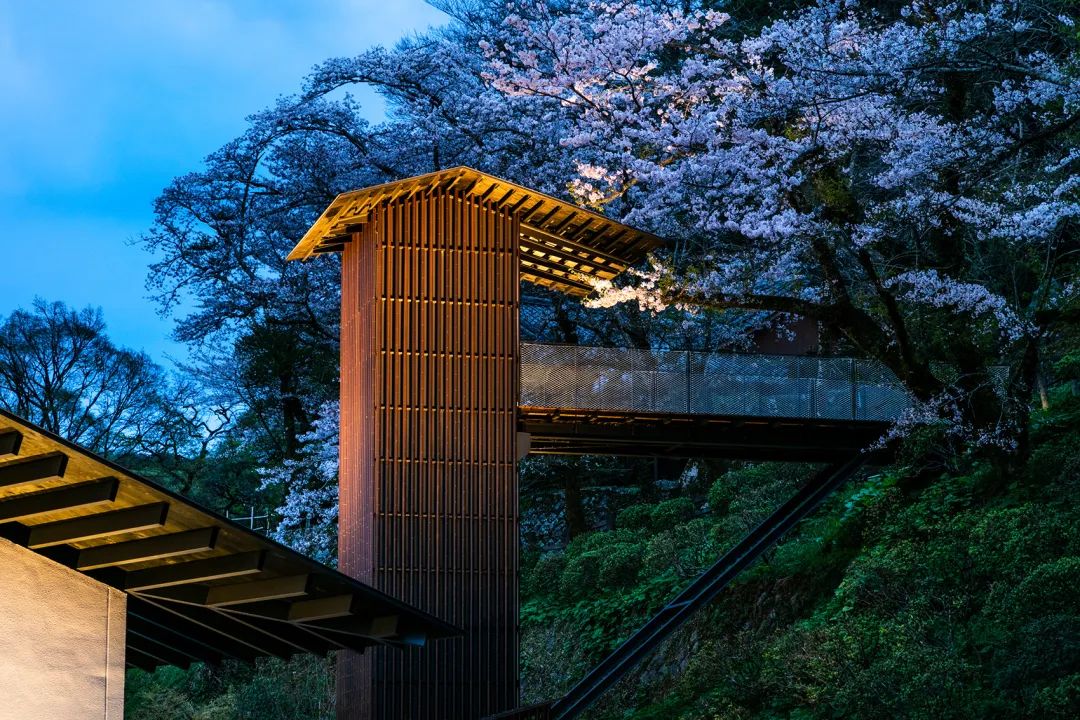

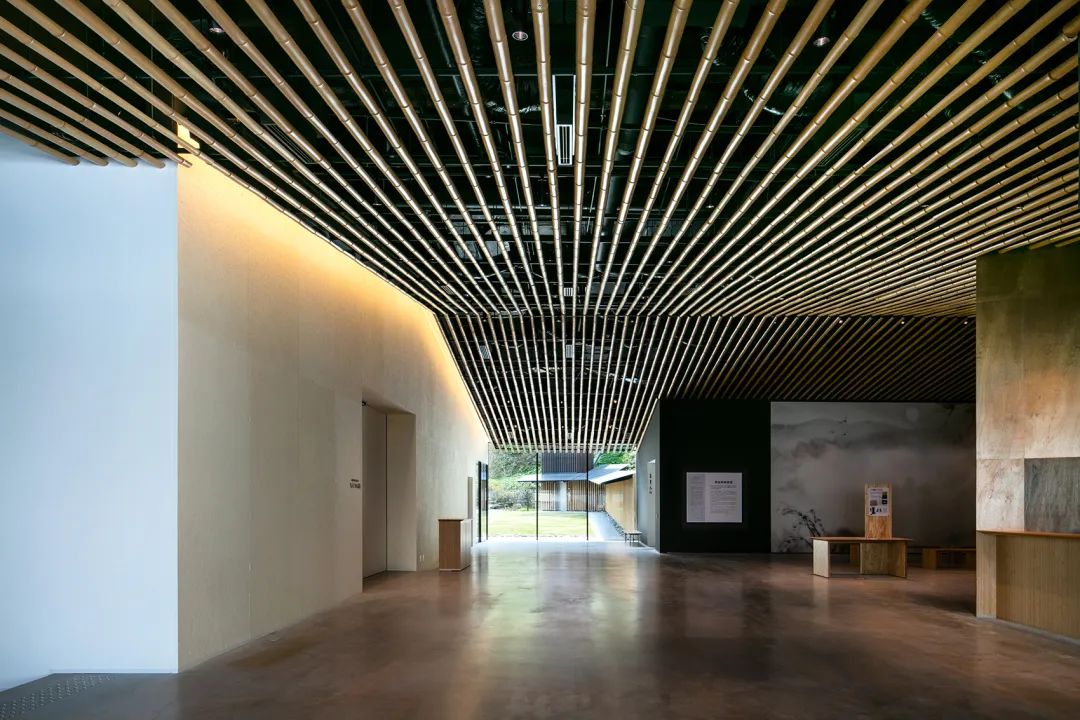

Kawasumi・Kobayashi Kenji Photograph Office
05.2020
日本morinos教学展亭
Morinos

Studio Any Ltd Matsushima
Morinos是一个教育设施,用于传授森林自然教育所具备的多种功能。大面积的斜屋顶由从森林中选取的V形原木支撑,形成一个非常开阔的空间,林业学院里的学生们会在其下方进行大量的科研和学习活动。学院旁边的研究林地中种植着具有百年历史的日本扁柏,它们由林学专业的学生砍下,与还残留着树皮的雪松木板组合在一起,作为开口处的门柱和竖框。这样的设计让材料本身发挥出传授林业知识的作用。
This is a facility for education programs to teach the multifaceted functions of forests. Workshops are repeatedly held with students of the academy under the lean-to roof with a large overhang which is supported by logs cut down from the forest in a V-shaped configuration, creating a very open space.One-hundred year old Japanese cypress logs in the research forest adjoining the academy were cut down by students majoring in Forestry studies, and used in combination with cedar planks that still have the bark on for the doorjambs and mullion for the openings. Therefore, the materials themselves are used in the design to teach forestry education.
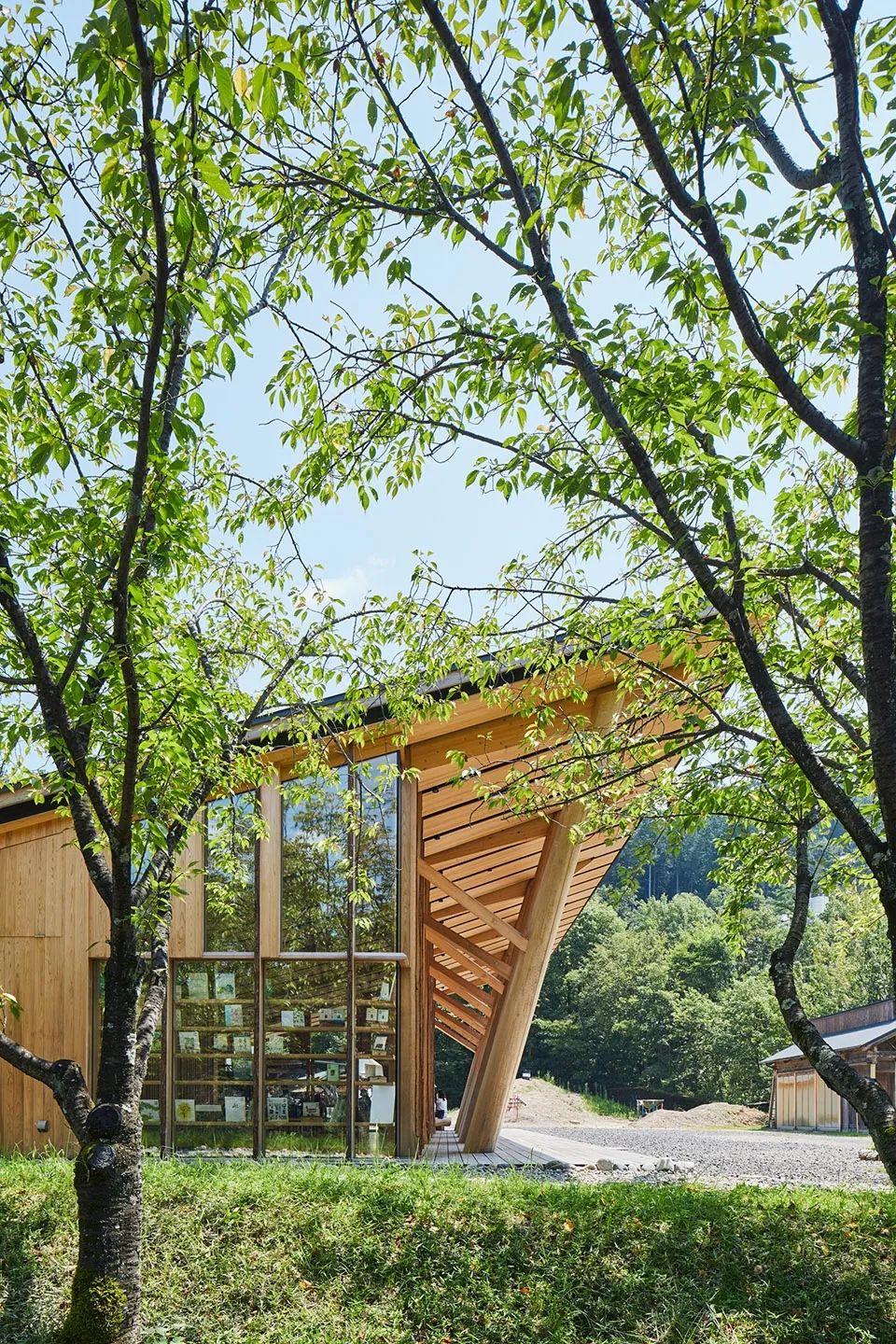
KenyaChiba
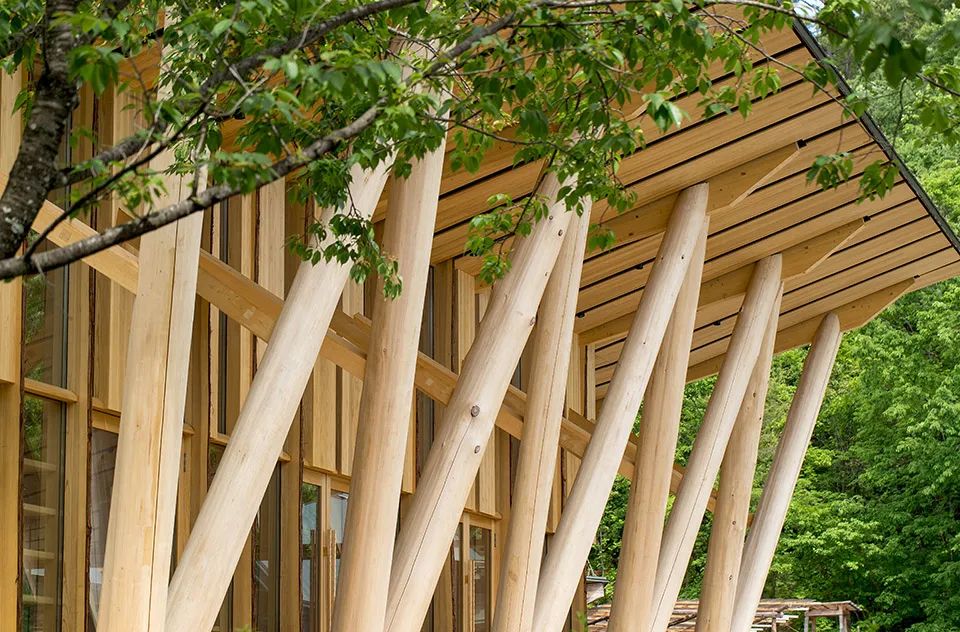
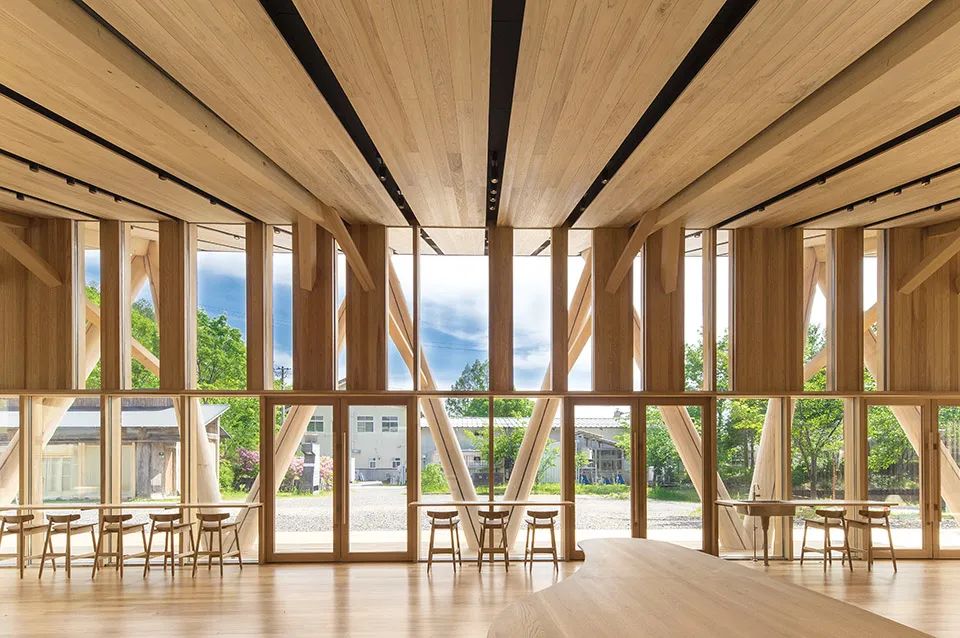

Studio Any Ltd Matsushima
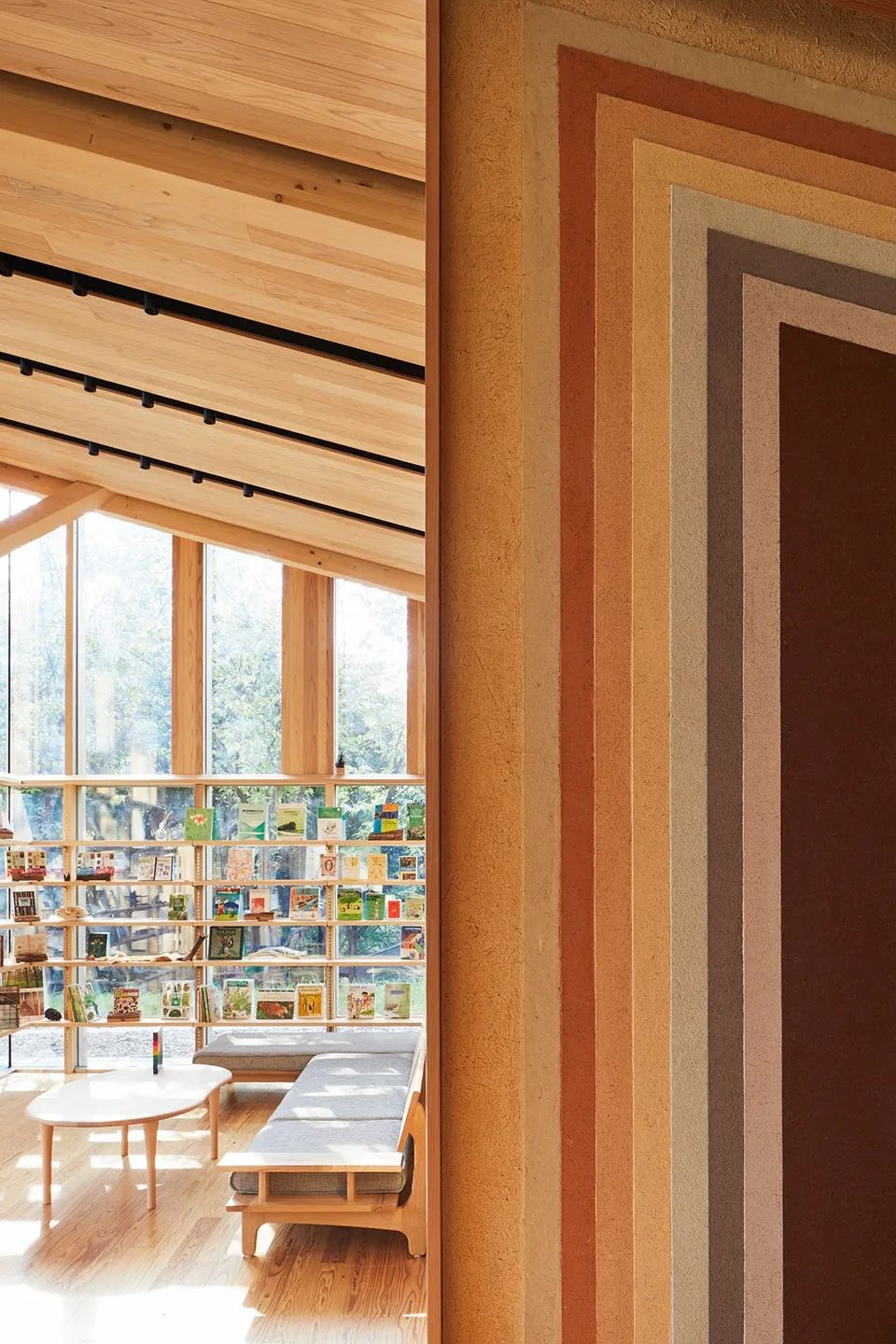
KenyaChiba
06.2019
日本桦树苔藓教堂
Birch Moss Chapel


▲图片来源于gooood
桦树苔藓教堂是设计师隈研吾为轻井泽新艺术美术馆建造的一座小教堂。建筑师的想法是将小教堂化作轻井泽的一片白桦林。建筑师用白桦树皮包裹垂直树立的钢结构,让它们仿佛是树林中的一棵棵树木一样支撑着小教堂的玻璃的屋顶。室内的长椅由玻璃和亚克制成,苔藓地面从室外延伸至室内,让教堂消解在白桦林中。
The architects randomly raised vertical steel structures wrapped in birch trunks to support the glass roof of the chapel as if they were individual trees in the woods. The benches are made of glass and arc, and the moss floor extends from the outside to the inside, allowing the church to dissolve into the birch forest.




▲图片来源于gooood
07.2019
日本明治神宫博物馆
Meiji Jingu Museum

Kawasumi・Kobayashi Kenji Photograph Office
博物馆位于明治神宫的主神社附近。博物馆不仅用于展览保存在神社里的艺术品与文物,也有对神社历史信息的展示及介绍。整栋建筑物与周边树木茂盛的森林完美融合。设计师通过限制屋檐的高度,将整体的斜坡形屋顶分解为多个小面积屋顶再组合,屋顶室外表面使用大和张力技巧(木板层叠排列),以达到将建筑融入森林中的效果。
The museum is located near the main shrine of Meiji Shrine. The museum is used not only to display art and artifacts preserved at the shrine, but also to display and introduce information about the history of the shrine. The building blends perfectly with the surrounding wooded forest. By limiting the height of the eaves, the sloping roof is broken down into multiple small roof areas and reassembled. The outdoor surface of the roof uses the technique of dawa tension (wooden planks stacked on top of each other) to achieve the effect of integrating the building into the forest.
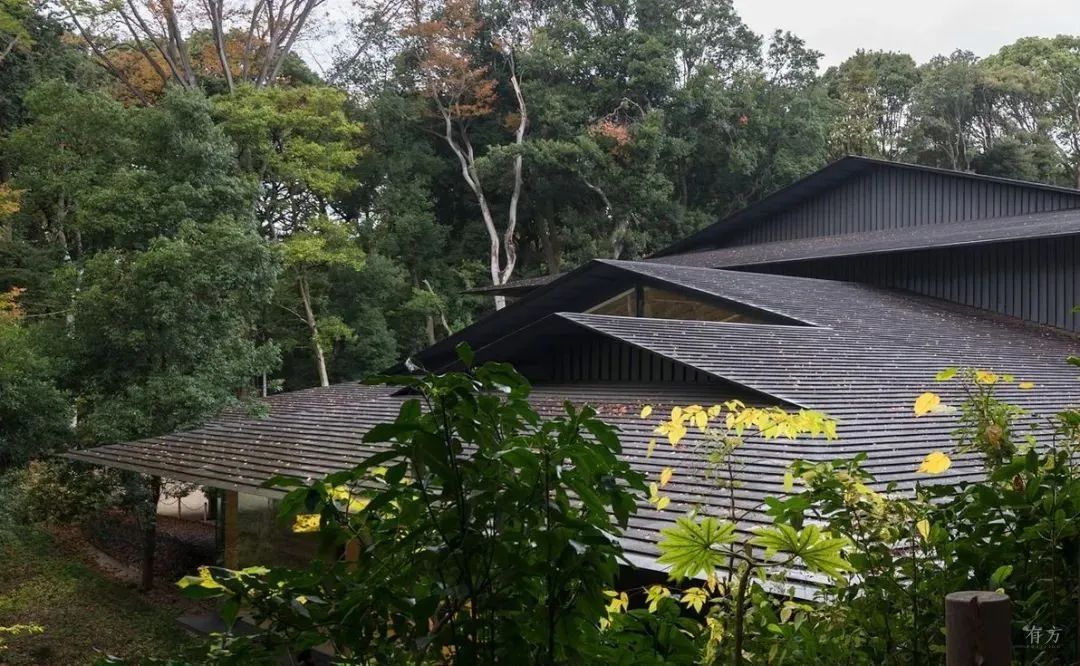

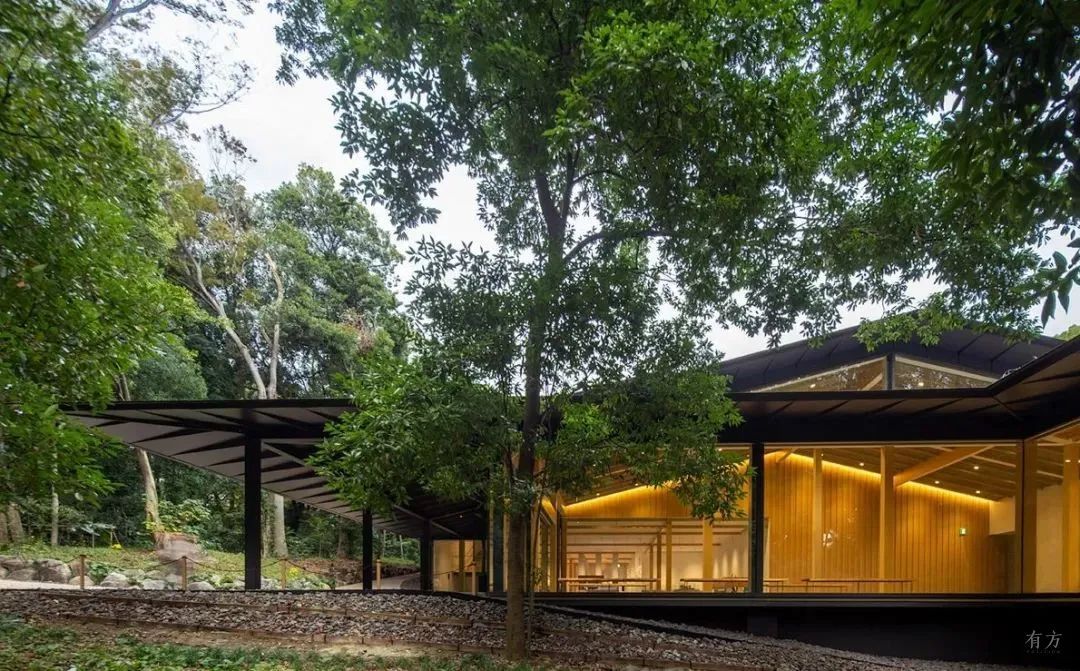
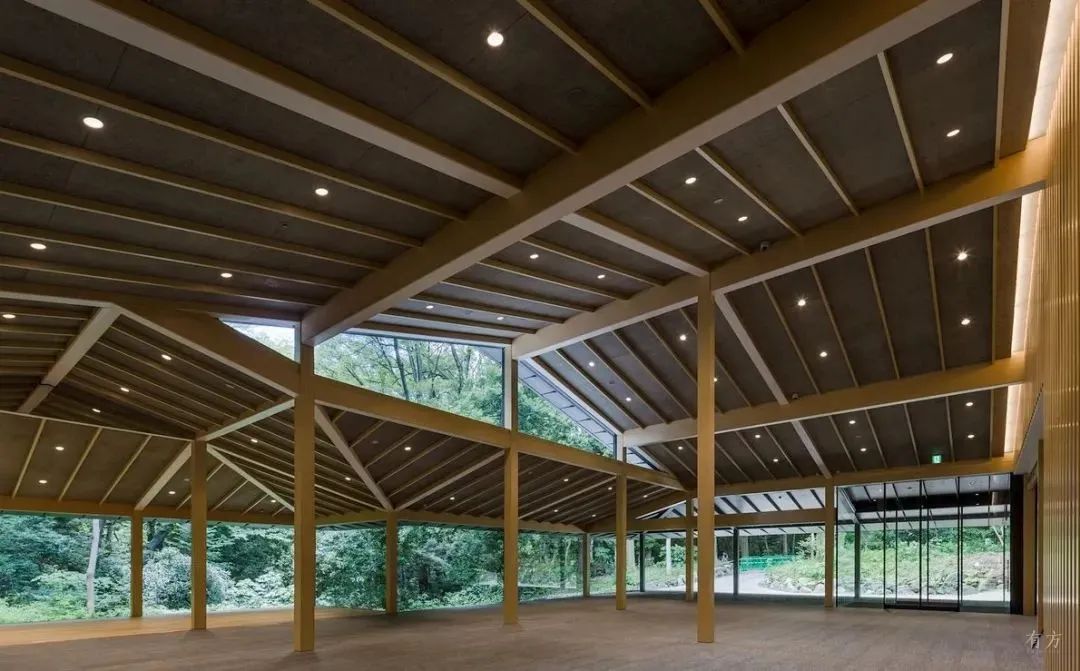
Kawasumi・Kobayashi Kenji Photograph Office
08.2017
美国波特兰日本庭院文化村(2020ASLA获奖)
Portland Japanese Garden Cultural Village

Jeremy Bittermann
建筑师隈研吾以及他的事务所团队,在美国波特兰日本庭院文化村此项目中以朴素的设计、人性化的尺度,将建筑围绕在了一个广场的周围,背靠一个自上世纪60年代保留下来的庭院。游客前往文化村需从城市出发再行至山顶,与日本文化中的朝圣之路相似旅人从禅院附近的城市门前町出发,在途中对大自然致以敬意。
Architect Kengo Kuma and his firm team have designed the Japanese Courtyard Cultural Village in Portland, USA, with an austere, human-scale design that surrounds a plaza backed by a courtyard that has been preserved since the 1960s. Visitors to the village start from the city and walk to the top of the mountain, similar to the pilgrimage route in Japanese culture, where they pay homage to nature from the nearby town of Menmen.


Walker Macy
项目场地位于斜坡之上,周围种有一片西北太平洋的松柏类植物。文化村的四座建筑,每一座都以其独特的方式与当地环境融合。建筑风格表现出了对自然景观的尊敬,特别是之字形的屋顶造型,创造出了一个由软金属材料和茂密植被组成的悬臂造型,同时它富有渗透性的边界和著名的波特兰雨以及变化无常的太阳也会形成一个柔和 、模糊和灵活多样的边界。
The site is located on a slope and is planted with conifers of the Pacific Northwest. Each of the four buildings in the cultural village blends with the local environment in its own unique way. Architectural style shows respect for the natural landscape, especially the roof of the of glyph shape, create a composed of soft metal materials and dense vegetation cantilever model, at the same time it rich in the boundary of the permeability and the famous Portland and the uncertainties of the sun, the rain will form a soft, fuzzy and flexible boundary.





Jeremy Bittermann
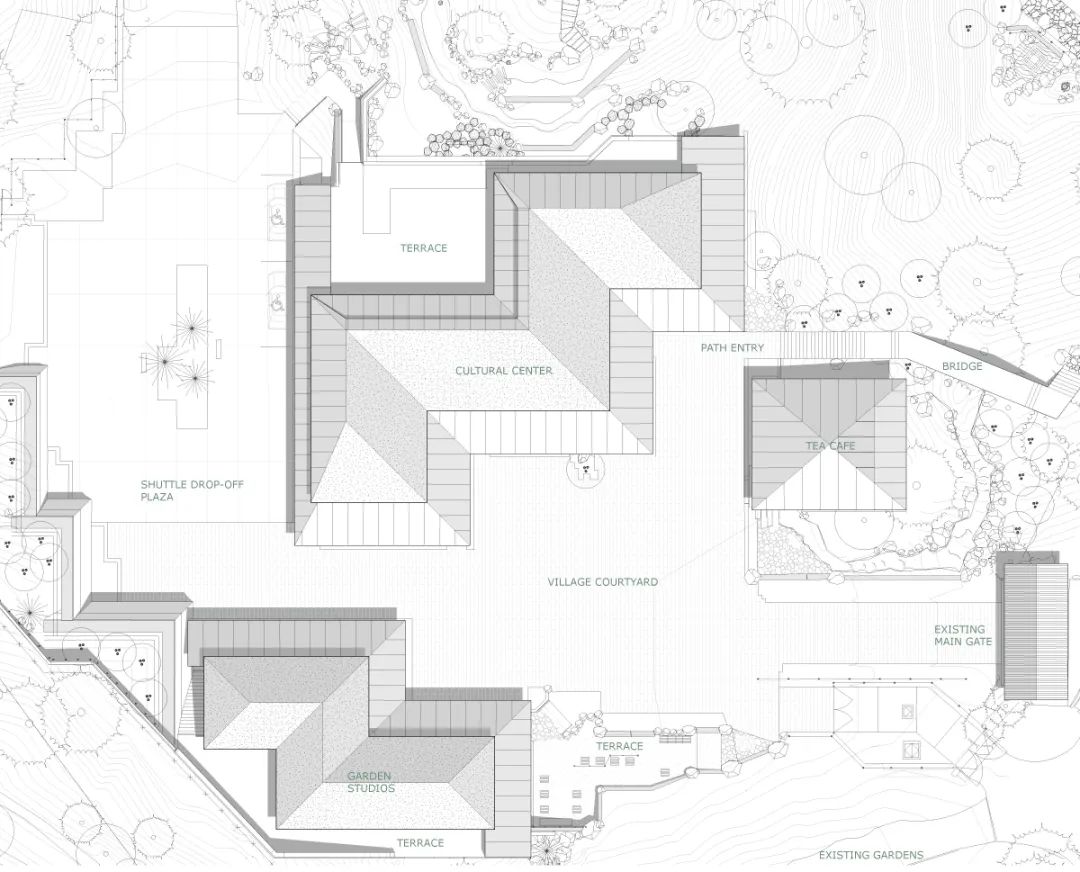
Kengo Kuma Associates
09.2015
中国美术学院民俗艺术博物馆
China Academy of ArtsFolk Art Museum
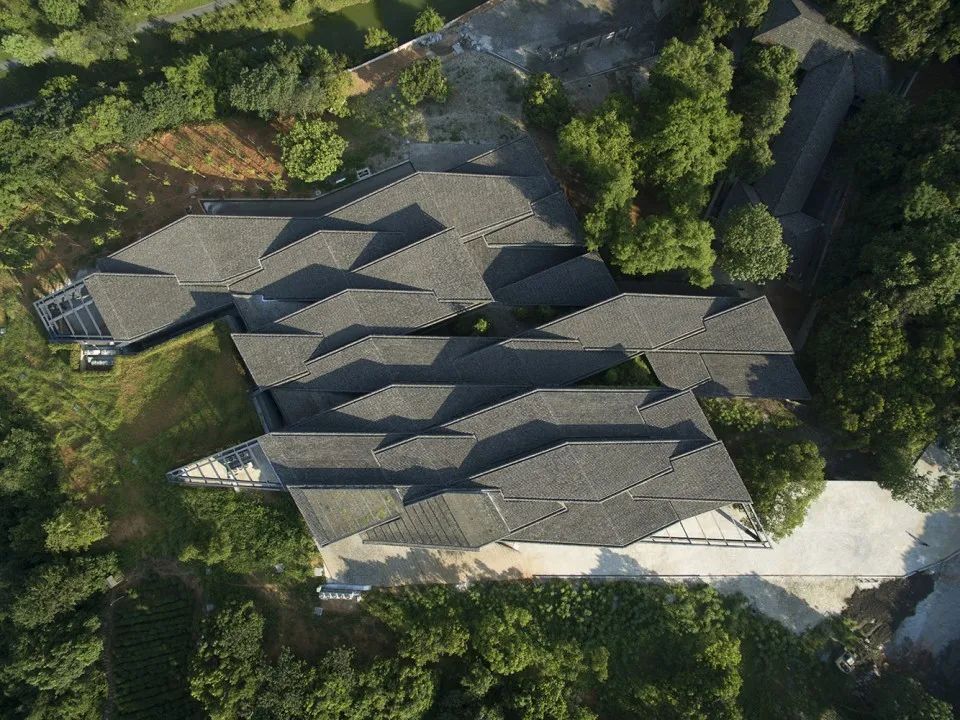
▲图片来源于gooood
民俗艺术博物馆坐落于中国美术学院校园内。原场地本是一座山坡上茶园。设计的初衷是要建造一座可以从地面上感知得到的博物馆,各楼层沿着坡地的起伏形成连续的空间。
The folk art museum stands in the campus of China Academy of Arts in Hangzhou. The site was formerly a tea field that formed a hillside. Our point was to design a museum from which the ground below can be felt, by continuing the buildings floors that follow the ups and downs of the slope.
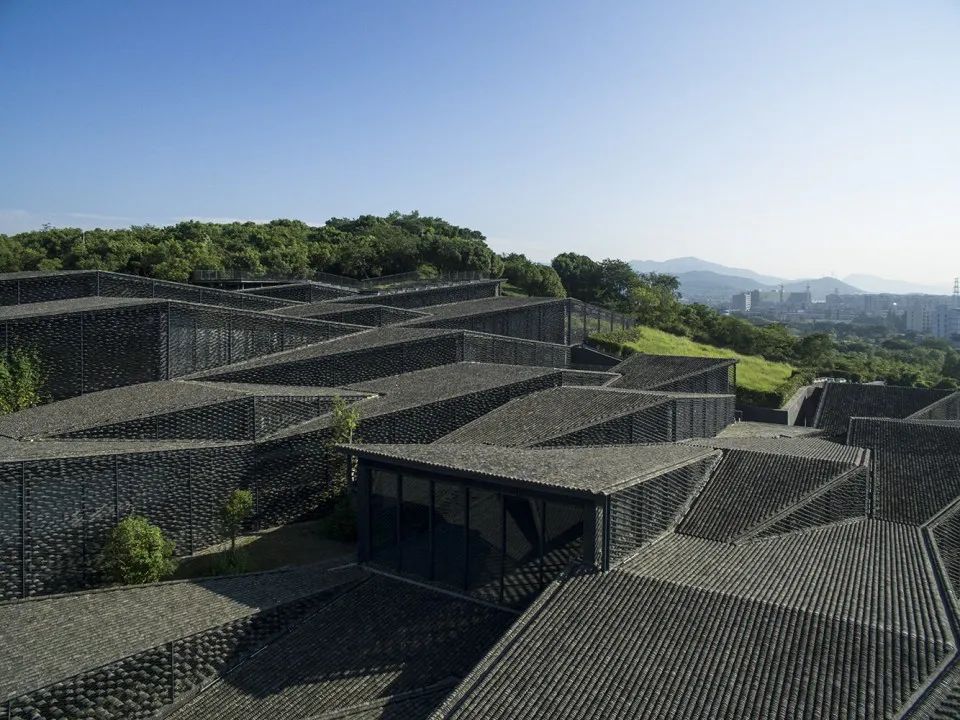
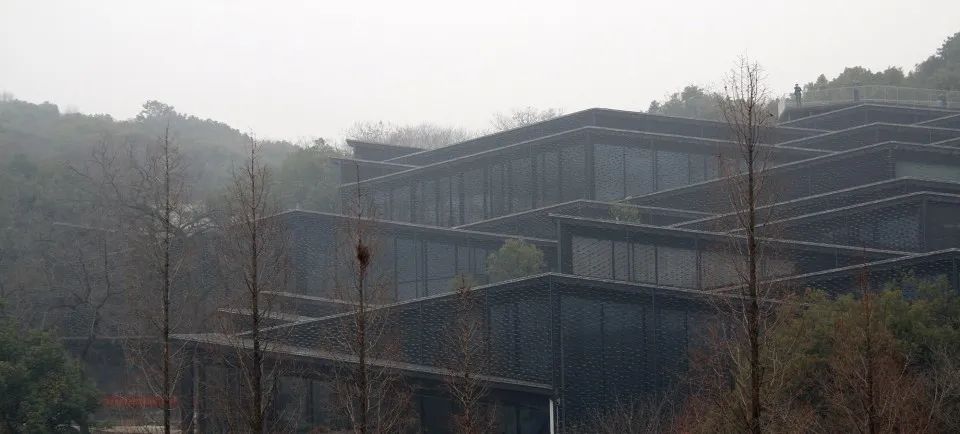

▲图片来源于gooood
设计师以平行四边形为基本单元,通过几何手法的分割和聚合,来处理错综错综复杂的地形。每个单元都有独立的屋顶,在外观上唤起人们记忆中鸟瞰村庄时青瓦连绵的景象。一片片由不锈钢索铆固着的瓦片构成了外墙的表皮,同时还起到控制室内光照的作用。建筑屋顶和外墙表皮所使用的大小不一的瓦片来自当地的传统房屋,这有助于建筑与环境完美地融合在一起。
Planning is based on geometric division in the units of parallelogram to deal with the intricate topography. Each unit has a small individual roof, so the outlook became like a village that evokes a view of extending tiled roofs.The outer wall is covered with a screen of tiles hung up by stainless wires, and it controls the volume of sunlight coming into the rooms inside.Old tiles for both the screen and the roof came from local houses. Their sizes are all different, and that helps the architecture merge into the ground naturally.

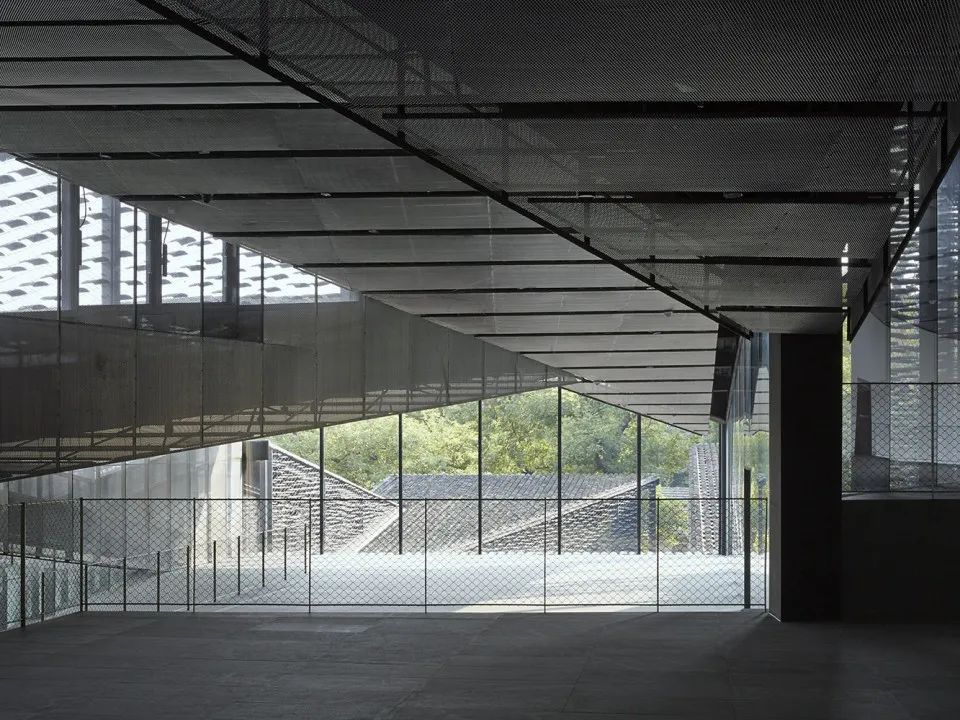
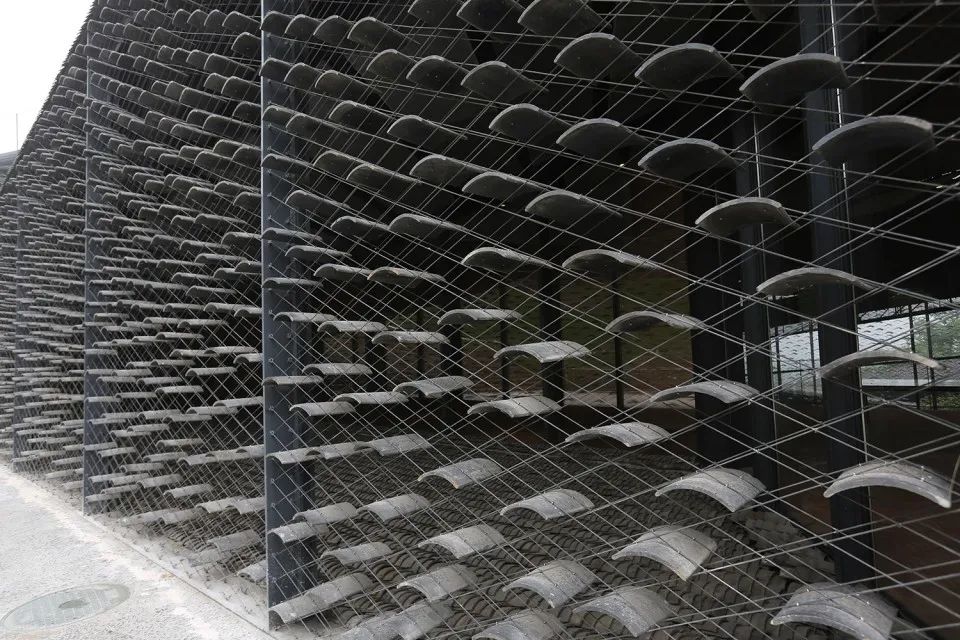
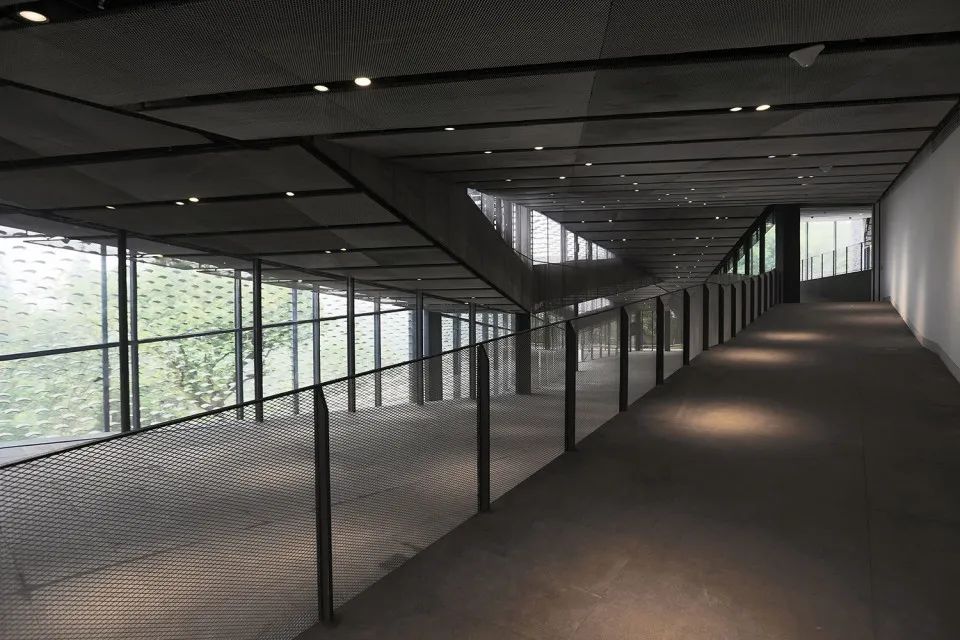

▲图片来源于gooood
10.2012
梼原木桥博物馆
Yusuhara Wooden Bridge Museum
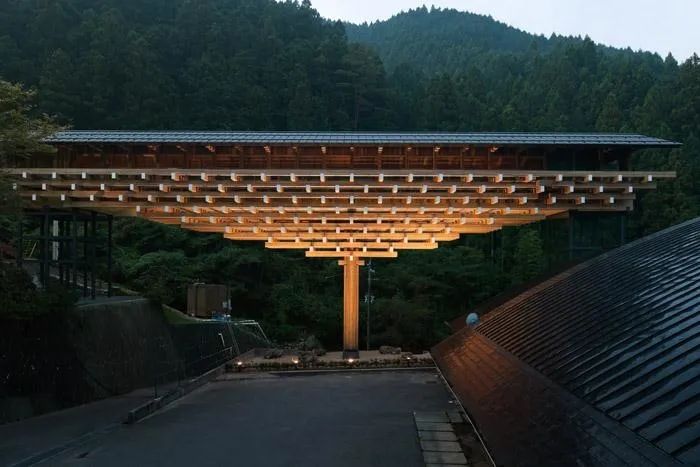
Takumi Ota
日本隈研吾建筑事务所设计的位于高知县的梼原木桥博物馆,桥体连接起被道路分开的两个公共建筑。桥型博物馆功能不仅仅是两个建筑设施建的通道,也用作艺术家的住宿和工作驻场地点。在这个项目当中,建筑师用小部件组成了结构体系,其灵感来源于日本和中国传统的悬臂式结构,并认为这是一个可持续发展的示范性案例,没有使用任何大型构件却能实现大悬挑。采用本地红衫木,建筑被设计成一个极具雕塑感的三角体量,并对邻近山体和森林表达敬意。
Kengo Kuma architects has designed a Goachi museum in Kochi prefecture that links two public buildings separated by a goachi road. The bridge museum functions not only as a gateway between the two building facilities, but also as a place for artists to stay and work. In this project, small parts form a structural system inspired by traditional Cantilevered structures in Japan and China, which the architects consider to be a demonstration case of sustainability, with large overhangs achieved without the use of any large components. Using local redwood, the building is designed as a sculptural triangular volume that pays homage to the nearby mountain and forest.

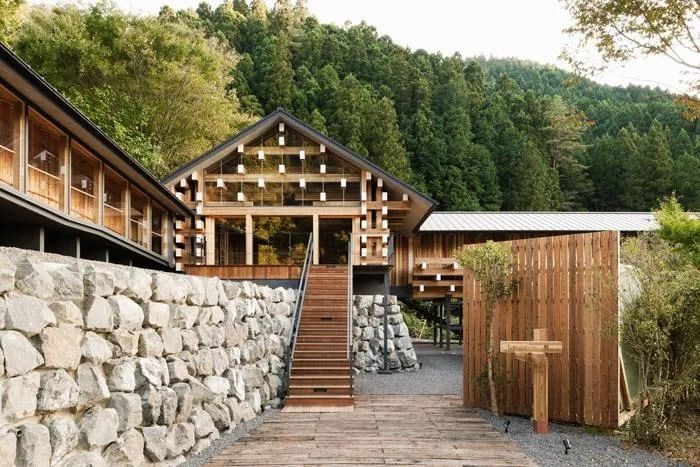


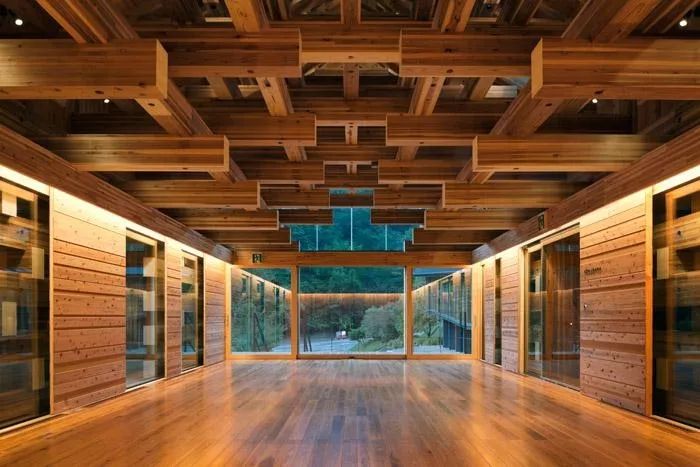
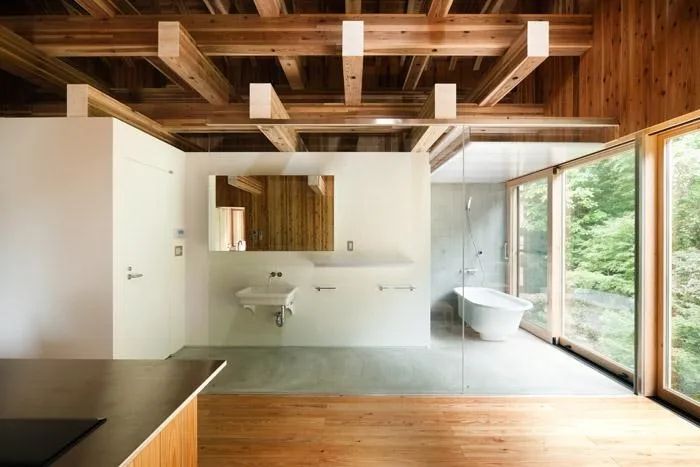
Takumi Ota
隈研吾曾说:能治愈心灵的温暖的设计对我的生活方式来说是最重要的。这不仅是他的生活方式,也是他建筑作品里的精神内核。Kengo Kuma once said, Warm design that heals the soul is the most important thing for my lifestyle. This is not only his way of life, but also the spiritual core of his architectural work. After appreciating the charm of the masters design with us, you are welcome to choice for your favorite works!




